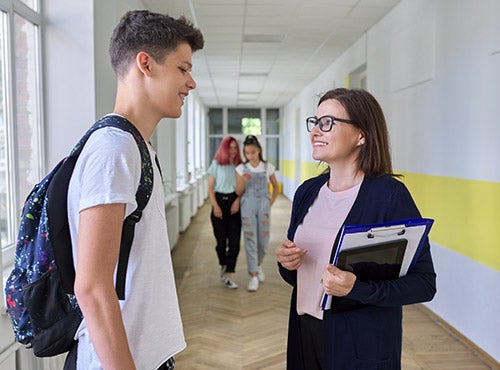
23 of your 27 students are at their desk working quietly. Occasionally, one of them raises his or her hand with a question. But then there are the other four... Mike is wandering up and down the aisles... Kristin has been sharpening the same pencil for 5 minutes... Chris has his head down on his desk... Sabrina is practically falling out of her chair trying to get your attention… and this most likely represents a good day.
Creating a classroom environment where everyone can learn, while also addressing the individual needs of each student, is not easy. You are constantly thinking about praising students, prompting desired behavior from individual students, maintaining behavior charts and addressing on-going negative behavior. All the while, you are also trying to manage the entire classroom.
Have no fear. Balancing this all while maintaining your sanity is possible.
1. Teach students classroom routines – Clear, consistent routines reduce chaos and make it more likely that students will be self-sufficient and behave as expected. Have routines for entering & exiting the classroom, conducting lunch count, completing morning work/bellwork, sharpening any pencils, getting necessary supplies, etc. Watch our FREE webinar for more tips.
2. Greet students at the door – A study from Allan Allday & Kerri Pakurar showed that greeting students at the door increased engagement and assisted students in getting on-task faster. Greeting students at the door allows you to have contact with each and every student and to gauge how they are doing that particular day – before class even begins! This short moment each day is a great way to build relationships.
3. Check in on students who seem a little “out of sorts” that day – Another benefit of greeting students at the door is that you will immediately know if students seem a little different than normal. Take the time to check in with those students individually during bellwork. Being proactive shows students you care about their well-being and can prevent problems from arising later in the day.
4. Circulate throughout the room – Proximity and engagement with students has also been shown to increase on-task behavior. Circulate during whole-class instruction to increase engagement. During group or independent work time, circulating the classroom will increase on-task behavior and improve learning. This will allow you to monitor students and interact with them individually. This is a key step in working to better meet students’ individual needs.
5. Have individual conversations with students – As you circulate, interact individually with students: smile, offer help, praise or redirect. Most importantly, talk quietly so only the student you’re addressing can hear you. Talking loudly to the whole class while addressing one student encourages others to stop doing their own work and listen. Having quiet, individual conversations with students ensures the rest of the class stays on-task. Doing so teaches students that you can have individual conversations with students without making them a big deal. This makes individual correction much easier and more personal.
6. Praise more than you correct – Students don’t care what you know until they know that you care. They are more likely to try hard and take risks when their efforts are recognized and praised more than they are corrected. When we praise purposefully more than we correct, we create a positive environment in which students feel safe to learn and take chances.
7. Begin correction with praise or empathy- Beginning correction with praise or empathy “disarms” students, so to speak. It communicates that this is merely a conversation, not a confrontation, making students more likely to accept correction.
When these structures and skills are in place, the classroom can function without the teacher running around playing whack-a-mole with student behaviors and constantly having to micromanage students. This can free the teacher up to circulate and facilitate while managing the entire classroom. Students also learn to manage their own behavior and be more empathetic and understanding when you need to spend extra time to assist their classmates.
